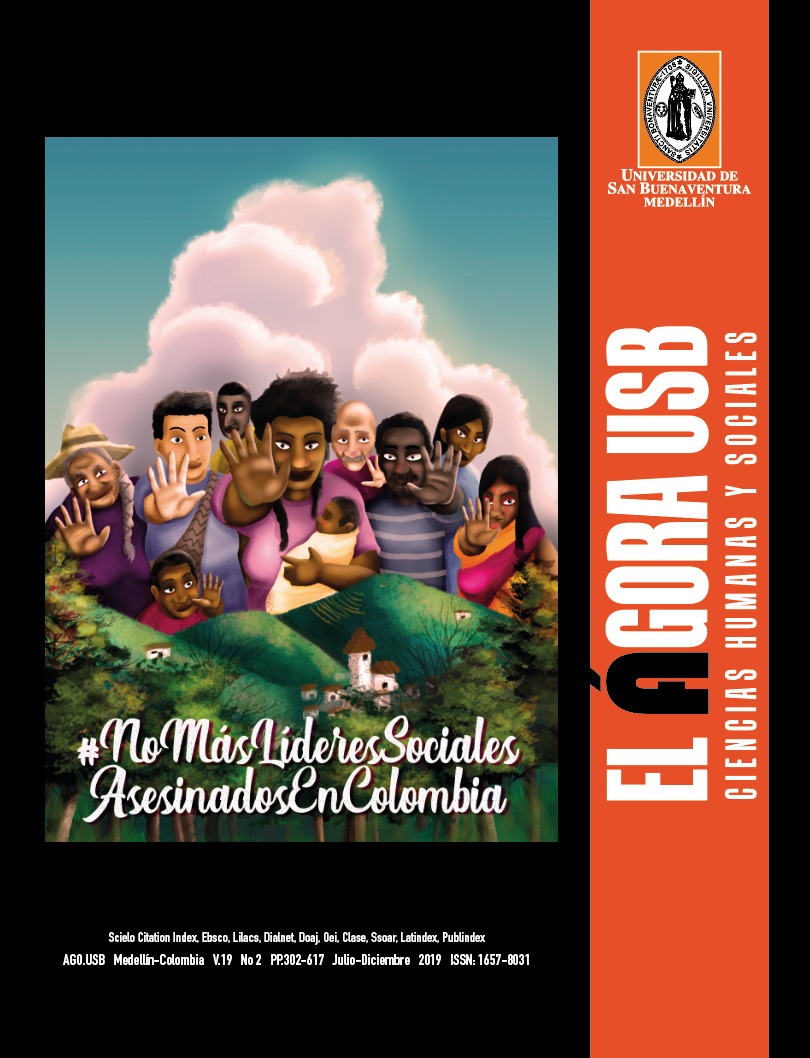The authors are also adhere to the creative commons license 4.0 (https://creativecommons.org/licenses/by-nc-nd/4.0/deed.es)
Attribution - NonCommercial - SinDerivar 4.0 International (CC BY - NC - ND 4.0)
Abstract
News broadcasts, which are projected onto national television (Colombia) are basically characterized by spreading news related to violence, politics, and corruption arising from it. These media influence somehow
the perception of citizens at the time of choosing candidates. Its main objective was to carry out a multivariate comparative and relational analysis in order to evaluate the perception of college students, on news programs, which are broadcast on Colombian television. According to the respondents, as a relevant conclusion, what is highlighted is that the government controls the news, and they affect negatively the repetitive form of addressing issues of violence.
Keywords:
References
Angulo, Lizandro (2013): “Análisis de contenidos del noticiero de RCN de Colombia desde
la perspectiva de la Comunicación, el conflicto y el desarrollo”. Oikema. Revista de
la Facultad de Ciencias Humanas y Artes.
Ardèvol, Alberto & Gil, Homero (2016): “Article Effects of Editorial Media Bias Perception and
Media Trust on the Use of Traditional”, Citizen, and Social Media News 1, 2. Journalism & Mass Communication Quarterly 1–22.
Babran, A & Ahadzadeh, S (2010): “Audiences’ Perception of Media Ethics Principles On Iran
Television News Sedigheh”. Intercultural Communication Studies XIX.
Bonilla, Jorge & Tamayo, Camilo (2006): “Medios de comunicación y violencias en América
Latina: preocupaciones, rutas y sentidos”. En: Controversia no. 187. Bogotá: CR,
ENS, IPC, FNC, CINEP.
Bozell, Brent (2012): “Media Research Center. An Open Letter to the Biased News Media”.
Brundidge, J et al. (2014): “Political participation and ideological news online: “Differential
gains” and “differential losses” in a presidential election cycle”. Mass Communication & Society, 17, 464-486.
Chan, Angela & Chan, Vanessa (2012): “Public Perception of Crime and Attitudes toward
Police: Examining the Effects of Media News”. Discovery – SS Student E-Journal
Vol. 1, 2012, 215-237.
CNTV: “Encuesta Nacional de Televisión, Año 2002”, www.cntv.cl
Cotes C & Kyrillos LR (2011): “Expressividade no telejornalismo: novas perspectivas”.
Atuação fonoaudiológica em voz profissional. São Paulo: GEN/Roca; p.75-97.
Constitución política de Colombia [Const.] (1991) artículo 20. Recuperado de https://www.
procuraduria.gov.co/guiamp/media/file/Macroproceso%20Disciplinario/Constitucion_Politica_de_Colombia.htm
Destiny, Apuke (2016): “Perception of News Commercialization and its implication on Media Credibility in Nigeria”. World Scientific News 55, 63-76.
Devaney, Haley (2013): “A Senior Honor Thesis Submitted to the Department of Political
Science”, University of California, San Diego.
Dutton, W. H. (2009): “The fifth estate emerging through the network of networks”. Prometheus, 27(1), 1-15.
Dutton, W. H., & Eynon, R. (2009): “Networked individuals and institutions: A cross-sector
comparative perspective on patterns and strategies in government and research”.
The Information Society, 25, 198-207.
Focás, Brenda (2013): “Inseguridad: En busca del rol de los medios de comunicación”. La
Trama de la Comunicación - Volumen 17 - pp. 163-174.
Gil de Zúñiga, H. (2015): “Toward a European public sphere? The promise and perils of
modern democracy in the age of digital and social media”. International Journal of
Communication, 9, 3152-3160.
Gómez, Juan et al. (2010): “Los noticieros de la televisión colombiana “en observación”.
Una mirada desde la academia a la estructura, cobertura y contenidos de los teleinformativos de la televisión abierta en Colombia”. Revista Palabra Clave. 13(2).
Granados, David (2013): “Derechos de autor en Internet para Colombia” Escuela de Ciencias Humanas Programa de Periodismo y Opinión Pública.
López, Rafael & Cerda, Aída (2001): “Violencia en la televisión mexicana: Un análisis del
contenido de los treinta programas con mayor audiencia”, en Hiper-textos, número
2 Monterrey.
Maldonado, Arturo (2011): “¿Quiénes consumen noticias en los medios en América Latina
y el Caribe?”, Perspectivas desde el Barómetro de las Américas: No 70, The Latin
American Public Opinion Project.
Martini, Stella. (2000): ”Periodismo, Noticia y Noticiabilidad”. Editorial Norma, Buenos Aires.
Morley, David. [EN LINEA]. [Citado 15/1/18 11.25 HR]. http://diegolevis.com.ar/secciones/
Articulos/Morley.pdf
Naresh, H & Ravi, B.K (2015): “Audience Perception of the Credibility of Local News Channels”, International Journal of Scientific and Research Publications, Volume 5, Issue 2.
Newman, Nic., Dutton, William & Blank, Grant. (2012): “Social media in the changing ecology of news: The fourth and fifth estates in Britain”. International Journal of Internet
Science, 7(1), 6-22.
Quackenbush, Daniel (2013): “Public Perceptions of Media Bias: A Meta-Analysis of American Media Outlets During the 2012 Presidential Election”. The Elon Journal of Undergraduate Research in Communications. Vol. 4, No. 2.
Soto, Susana (2005): “La influencia de los medios en la percepción social de la delincuencia”. Revista Electrónica de Ciencia Penal y Criminología.
Tai, Z. (2000): ”Media of the World and World of the Media: A Cross-National Study of the
Rankings of the `Top 10 World Events’ from 1988 to 1998”. International Communication Gazette, 62(5), 331-353.
Takahashi, Bruno (2013): “La influencia de las agencias internacionales de noticias en la
cobertura de los efectos y las soluciones del cambio climático: un estudio de caso
del Perú”. Razón y Palabra. Número 84.
Tapia, Gonzalo (2008): “La noticia son los medios: la audiencia opina de los noticieros”. Revista Percepciones y actitudes sociales. Informe de Encuesta Nacional ICSO-UDP
Wu, H. D. (1998): “Investigating the Determinants of International News Flow”. International
Communication Gazette, 60(6), 493-512.




















